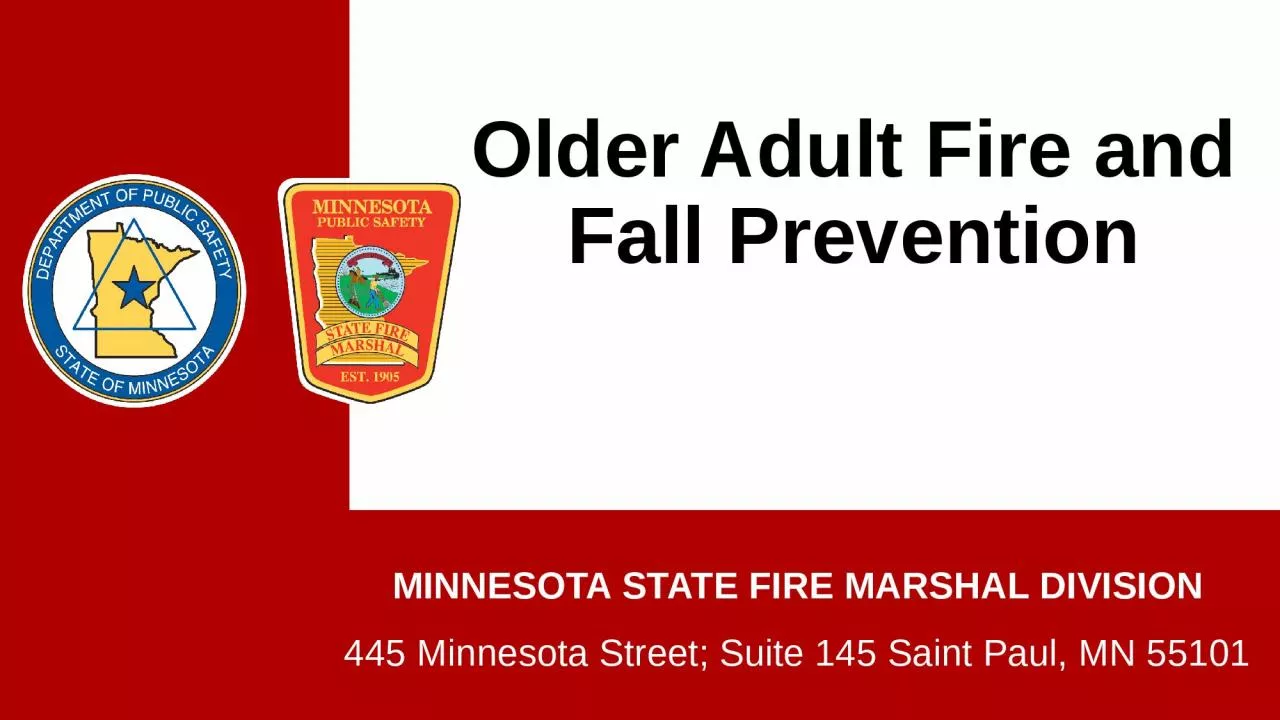

Minnesota 65 2015 2035 Minnesota Fire Deaths by Age 20082017 Minnesota Fire Deaths Metro vs Greater MN Follow these tips for safety Install amp Maintain Smoke Alarms You need working smoke alarms ID: 1041560
Download Presentation The PPT/PDF document "Older Adult Fire and Fall Prevention" is the property of its rightful owner. Permission is granted to download and print the materials on this web site for personal, non-commercial use only, and to display it on your personal computer provided you do not modify the materials and that you retain all copyright notices contained in the materials. By downloading content from our website, you accept the terms of this agreement.
1. Older Adult Fire and Fall Prevention
2. Minnesota 65+20152035
3. Minnesota Fire Deaths by Age (2008-2017)
4. Minnesota Fire Deaths – Metro vs. Greater MN
5. Follow these tips for safety
6. Install & Maintain Smoke AlarmsYou need working smoke alarms on every level of your home and in each bedroomTest each smoke alarm monthlyChange the batteries once a yearReplace alarms after 10 years
7. If You Smoke…Never smoke in bed, while drowsy or under the influence of medication or alcoholUse large, deep ashtraysNever smoke near or while using medical oxygen!
8. If You Smoke…Store lighters and matches up high, away from the reach of visiting children!Studies show that about 38 percent of children ages 6-14 have played with fire at least once.Nearly 80 percent of those children were playing with lighters or matches
9. Home OxygenIf you’re using home oxygen, you should not smoke – and family and friends should not smoke around youUsing home oxygen increases the risk of fires and burnsKeep home oxygen and tubing 10 feet away from heat sources
10. Cooking Fire FactsCooking is the leading cause of fire in MinnesotaTop three factors in cooking fires:unattended equipmentcombustibles too close equipment turned on accidentally
11. Pay Attention to Your CookingRemain in the home if you are simmering, baking, roasting, or boiling food, and check it regularlyUse a timer to remind you that you’re cookingStay in the kitchen when you are frying, grilling, or broiling food – If you leave the kitchen for even a short time, turn off the stove
12. Cooking SafetyKeep area clean and clutter-freeKeep cooking surfaces and surrounding areas free from clutterClean any grease build-up
13. Cooking Fire & Burn PreventionBe careful around stoves!Wear short sleeves or roll up loose-fitting sleevesKeep pot handles turned inwardUse pot holders and oven mittsNever lean over a hot burner
14. Three Feet From Heat3 foot sphere clearKidsPetsYouSpace heaters need space
15. Candle SafetyUse flameless, battery operated candles.Put candles in sturdy metal, glass, or ceramic holdersPlace candles where they cannot tip overNever leave a lit candle unattendedBlow out candles after use and before going to bed
16. Woodstoves & FireplacesNever use gas or lighter fluid to start a fire in a fireplace or wood stoveNever burn cardboard boxes, newspaper, wrapping paper or trashUse a metal or glass fireplace screen to keep sparks from hitting nearby carpets or furniture
17. Heat Your Home SafelyHave all heating equipment serviced annually by a professionalKeep combustibles and things that can burn or melt away from heaters, furnaces, fireplaces and water heatersNever use a range or oven to heat your home
18. Carbon MonoxideUnborn babies, infants, children, seniors, and people with heart or lung problems are at greatest risk from CO poisoningMinnesota law requires at least one CO alarm within ten feet of each sleeping area in all residences
19. Carbon MonoxideCarbon monoxide (CO), is an invisible, odorless, colorless gas created when fuels burn inefficientlyCO can result from faulty furnaces or other gas appliances, portable generators, water heaters, clothes dryers, or cars left runningHave fuel-burning appliances, furnaces, venting and chimneys checked annually by a professional
20. Carbon Monoxide PoisoningSymptoms include headache, nausea, and drowsinessExtremely high levels of poisoning can be fatal, causing death within minutesCarbon monoxide poisoning usually occurs in winter months, when heat sources may produce hazardous carbon monoxide levels
21. Electrical SafetyHave a professional electrician inspect your home’s wiring at least once every 10 yearsNever overload the electrical systemAvoid using extension cordsUse outlet covers if small children visit
22. Electrical SafetyReplace outlets if plugs do not fit snuglyUse ground fault circuit interrupters in rooms where water may be present
23. In Case of Fire…Practice two ways out of every roomCall 9-1-1, preferably from a neighbor’s phoneKnow the escape plan for the buildings you frequent
24. In Case of Fire…Get out as soon as you discover a fire!Don’t try to fight the fireOnce out – stay out!!
25. Stay ActiveTo reduce the incidence of falling:Exercise regularlyJoin a exercise groupWear sturdy shoes with no slip solesTalk to your pharmacist
26. Take Your TimeBe aware of your surroundingsBe aware of petsTake your time to answer the doorConsider using a cane
27. Uneven and Slippery SurfacesAvoid using throw rugsUneven pavementSeasonal hazardsUse railingsHousekeepingGrab barsNon-slip bath mats
28. Lighting and StairsNight lightsOptical appointmentsRailingsOutdoor lightingAddress numbersHousekeeping
29.
30.